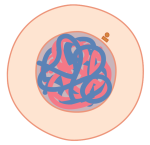1. Introduction
Let’s review the key points of meiosis through the following quiz.
[qwiz qrecord_id=”sciencemusicvideosMeister1961-Meiosis Review (v2.0)”]
[h]Meiosis Review
[i]
[q]Meiosis creates the [hangman] gametes (B) that fuse during the process of [hangman] (I).
[c]aGFwbG9pZA==[Qq]
[c]ZmVydGlsaXphdGlvbg==[Qq]
[q]Meiosis reduces the number of chromosomes in a somatic cell by [hangman]. The chromosome number starts as [hangman] or 2n, and gets reduced to [hangman] or n
[c]aGFsZg==[Qq]
[c]ZGlwbG9pZA==[Qq]
[c]aGFwbG9pZA==[Qq]
[q]Meiosis creates variation in two ways. What’s shown below is a preview of genetics, but you should be able to see that it refers to [hangman] [hangman] of maternal and paternal chromosomes.
[c]aW5kZXBlbmRlbnQ=[Qq]
[c]YXNzb3J0bWVudA==[Qq]
[q]Meiosis creates variation in two ways. What’s illustrated below refers to [hangman] [hangman]. During this process, homologous chromosomes come together to form a [hangman] (step 2). The new chromosomes that result are [hangman], because they combine the DNA of the parental chromosomes in a unique, never before seen sequence.
[c]Y3Jvc3Npbmc=[Qq]
[c]b3Zlcg==[Qq]
[c]dGV0cmFk[Qq]
[c]cmVjb21iaW5hbnQ=[Qq]
[q]After [hangman] (in step 3), the process of [hangman] (in step 5) amplifies the creation of variation by combining the DNA from each parent into a diploid [hangman], which then develops (step 7) into an adult.
[c]bWVpb3Npcw==[Qq]
[c]ZmVydGlsaXphdGlvbg==[Qq]
[c]enlnb3Rl[Qq]
[x][restart]
[/qwiz]
2. Meiosis: The Whole Shebang
With these concepts in hand, let’s walk through the whole process.
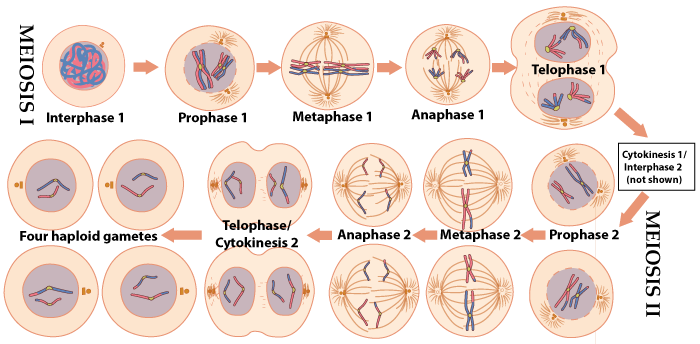
| Interphase I: |
|
Meiosis begins exactly as mitosis begins: During interphase 1, the chromosomes replicate. The chromosomes at this time are spread out and can’t be seen distinctly. |
| Prophase 1: | 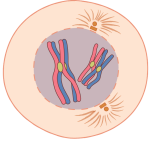 |
The chromosomes shorten, thicken, and become visible. Each chromosome is doubled, consisting of two sister chromatids attached by a centromere.
During prophase I, tetrads form and crossing over occurs, creating unique, recombinant chromosomes. |
| Metaphase 1 | 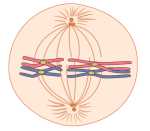 |
Just as in mitosis, a spindle forms during meiosis. This spindle grabs the homologous pairs and pulls them to the cell equator. This is where the independent assortment of chromosomes gets set up. Note that in the diagram to the left, crossing over has already occurred, so some of the chromatids are shown as recombinant chromatids.
In addition, note that while the cell show has both (mostly) maternal chromosomes on top and both (mostly) paternal ones below, the arrangement could just as easily be maternal 1 above, paternal 2 above; maternal 1 below, paternal 2 below (which, of course, is what independent assortment is all about). |
| Anaphase 1 |  |
During anaphase 1, homologous pairs are pulled apart. One complete haploid set of chromosomes moves toward each pole of the cell. Note that each chromosome is still doubled, consisting of two sister chromatids. |
| Telophase I: | 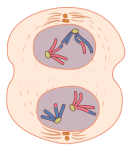 |
During telophase 1, a new nuclear membrane forms around each set of chromosomes. Each nucleus contains one member from each pair of homologous chromosomes (making them haploid). Because of crossing over and independent assortment, the nuclei are not identical, but they are equivalent in terms of the genetic information that each one contains. The word for that, of course, is homologous. |
| Cytokinesis 1,
Interphase 2, Prophase 2 |
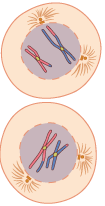 |
Cytokinesis 1 follows telophase 1, and the cell splits into two. Again, the two daughter cells are haploid, but with doubled chromosomes, each consisting of two sister chromatids.
A second interphase might follow, with chromosomes spreading out and becoming indistinct. If there is an interphase 2, there will not be an S-phase (no DNA/chromosome duplication occurs). In some species, the cells might move directly into prophase 2, as shown. The key is that the chromosomes are condensed, and ready to be manipulated by the spindle in subsequent stages. |
| Metaphase 2 | 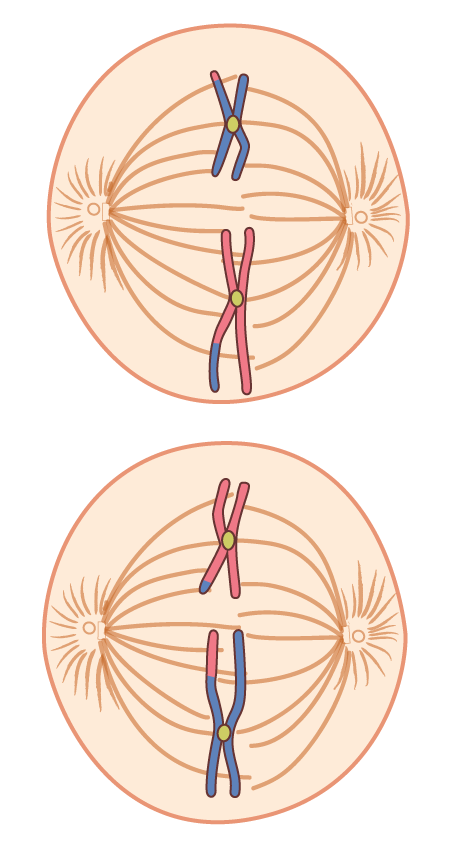 |
Another spindle forms. The doubled chromosomes are brought to the cell equator.
Note that the alignment of each pair of chromatids is separate from every other pair. That means that metaphase 2 (and the anaphase that follows) constitutes another round of independent assortment, creating more variation in the gametes. |
| Anaphase 2 | 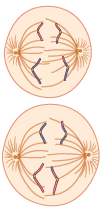 |
Sister chromatids are pulled apart. |
| Telophase 2
|
 |
A nucleus forms around each set of chromosomes. Each nucleus consists of a haploid set of single (as opposed to doubled) chromosomes. |
| Cytokinesis 2 | 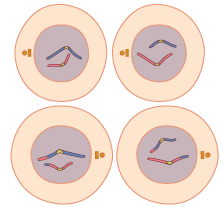 |
The cells split apart into separate cells. We now have four haploid gametes.
In a male, each of these four cells will become a sperm cell. During meiosis in females, most of the cytoplasm gets shunted off to one of the four cells. This cell will become the egg, while the other three cells are either sacrificed or go on to play a supporting role during fertilization and early development. |
3. Quiz: Phases of Meiosis
Now let’s see how well you understand how meiosis works. To keep you on your toes, I’m switching up the diagrams.
[qwiz random= “true” use_dataset=”Phases of Meiosis” qrecord_id=”sciencemusicvideosMeister1961-Phases of Meiosis (v2.0)”]
[h]Quiz: Phases of Meiosis
[i]If you need to stop before finishing, you can pick up where you left off by clicking “new” on the next card.
[/qwiz]
4. Meiosis, Music Video
5. What’s next?
Now that you understand how meiosis works, it’s time to look at some of the consequences of meiosis. This leads to our next tutorial: Topic 5.6, Part 1: Sex Determination.

